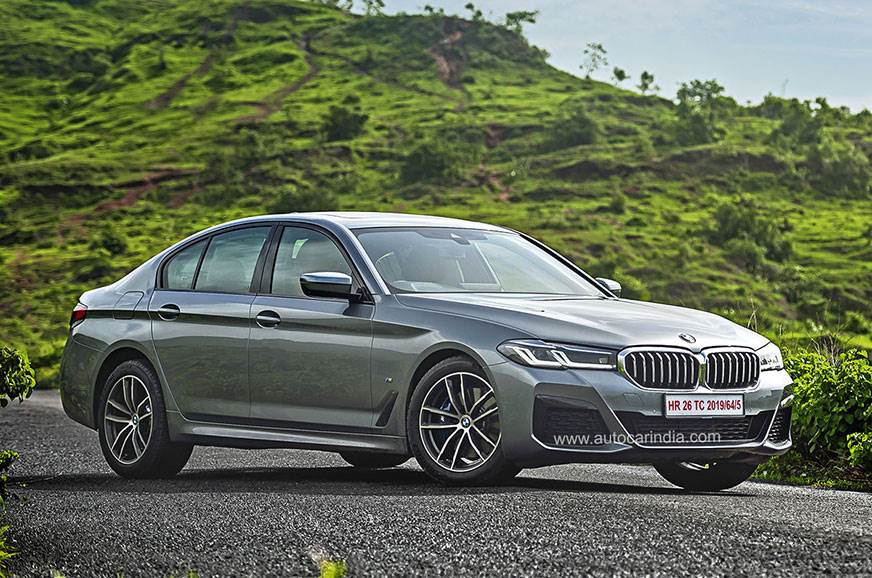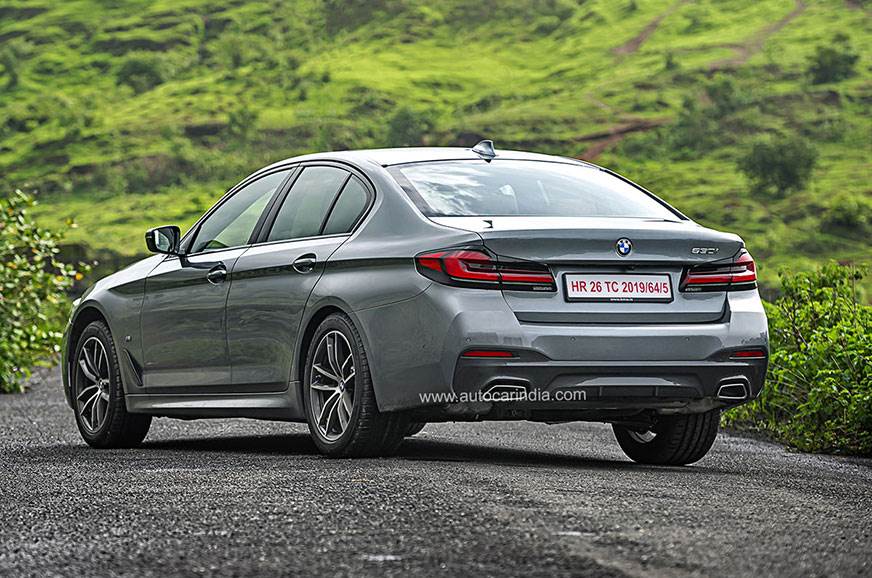With the BMW sedan range having grown to eight models, the 5 Series, more than ever before, feels like the perfect mix.
Published on Jun 24, 2021 12:30:00 PM
78,590 Views
Follow us on
It’s been four years since the G30 BMW 5 Series was launched in India, and now, hot on the heels of its bigger sibling, the 6 Series GT, it’s been given a facelift. However, since 2017, the segment has evolved too, with the Mercedes E-Class having gotten its own facelift and moved further upmarket and the launch of the new Audi A6. Moreover, BMW’s own sedan range has expanded to include the 3 Series Gran Limousine and 6 Series GT, which flank the 5 on either side. So have all these introductions squeezed the Bavarian midsize luxury sedan into insignificance? Not in the slightest.
The exterior changes are as you expect – primarily a new grille, bumpers and lights – but they all work really well to sharpen up the already well-proportioned 5 Series. The grille is taller, wider and more rectangular, but not quite as large or polarising as you’ll find on a 7 Series, and it sits lower in the nose too. Moreover, it has more ‘tipped forward’ protruding slats that signal a sportier intent. The headlamps are squared off too, with adaptive LED lighting as standard and LaserLight high beams on M Sport variants. The new double-L-shaped DRLs mean the end of BMW’s classic ‘corona ring’ signature, but the new design adds a lot more menace.

Similarly, the new design for the LED tail-lamps is a lot bolder, as are the trapezoidal tailpipes. The bumpers on this M Sport variant are a lot more angular too, and though unchanged from before, don’t you just love the design of the twin-five-spoke 18-inch alloy wheels?
Not a whole lot has changed inside, but the key difference is a much larger 12.3-inch touchscreen for the i-Drive infotainment system, which remains one of the best in the business. I would, however, be remiss not to report that the system on this particular test car did crash on us inexplicably, several times. Apart from the host of functionality it offers, including a digital assistant, a 360-degree camera, auto parking assist and wireless Apple CarPlay, you now also get Wireless Android Auto and the reversing assistant, which records the last 50 metres of forward travel, and can then recreate them perfectly in reverse; in effect to help you get out of a tight spot you’ve driven into. There’s also the fun (if slightly gimmicky) remote park feature, which lets you move the 5 Series forward and back via the remote key fob, while you’re outside the car. This ‘Display Key’ with its inbuilt touchscreen, lets you also check the fuel level, pre-cool and start the car remotely.

Speaking of displays, the 5 has inherited BMW’s latest 12.3-inch ‘Control Display’ digital instruments screen, which, though cool to look at, just isn’t easy to read on the move, especially in Sport mode. The simpler digital dials of the outgoing car were far better in this regard. But one thing we do have to commend BMW for is building in redundancy while adopting the latest tech – for example, there’s still one USB 2.0 port, in case you don’t yet have a cable that fits the rest of the USB-C ports in the cabin, and though there’s now voice, gesture and touch controls, you still get the classic i-Drive click-wheel controller, which is still the best way to use the system on the move.

The front seats have been given a small but crucial upgrade too – lumbar support adjustment, which was shockingly missing on lower variants of the outgoing car. The seats themselves are, as before, big, supportive and generously bolstered, and you even get a pull-out thigh support extension. In terms of overall appearance, things are largely the same, with a few more brushed chrome embellishments for the switchgear, four-zone climate control as standard, and a touchscreen for the AC blower controls at the front.

The rear seat remains generously cushioned, wide and spacious for two or even three, but it isn’t quite as plush or comfy as the one in the Audi A6, and certainly not the E-Class. It’s set quite low and has a rather upright backrest, and perhaps to put some distance between it and the bigger, comfier 6 GT, there’s just a standard sunroof, not a panoramic one. In isolation, however, this is an excellent rear seat even for the chauffeur driven, and not a deal breaker at all.
This is, of course, the arena in which the BMW 5 Series throws its best punches and sets itself apart from its peers. But as this segment moves up in price and ever closer to limousine territory, how relevant are fun driving dynamics anymore? The answer is probably close to zero, which is what makes the BMW’s tightrope-thin ride and handling balance all the more impressive.
This 530i M Sport we’re testing here, on its 18-inch wheels, large tyres and steel springs, rides just superbly. Bump absorption is superb and it would take the hardest of hits on the sharpest of bumps to unsettle the car. It perhaps lacks the ultimate plushness of the also-steel-sprung A6 on its tall tyres, but then the A6 cannot handle like the 5 Series. Adaptive dampers are standard across the range now, and they do wonders to add in a bit more firmness instantly for a more spirited drive. In fact, it does make you wonder if you really need the cost and complexity of air suspension at all.

The 530i continues with a 252hp, 350Nm 2.0-litre four-cylinder engine (the 190hp 520d and 265hp 530d are back too), and it is a strong and gutsy engine that changes sufficiently, depending on the mode you’re in. Sure, Eco Pro can feel a little dull at times, but that’s only to be expected when eking out every last kilometre from your tank of petrol. It will even shut off the engine and coast when you’re just cruising. Comfort is the mode you’re likely to find yourself in the most, for the refinement, throttle smoothness and ride comfort, but if you really want to get moving, put it in Sport and tap the gear lever to the left.

It's here you’ll truly appreciate that, despite going bigger and softer with the 5 Series, BMW has managed to keep the Ultimate Driving Machine alive. The steering gets weightier and the body control tauter (the ride gets a little fidgety of course), and the smooth powertrain is chomping at the bit. Despite having been downsized to four cylinders years ago, this 30i motor now really lives up to its legendary name.
The BMW sedan range has grown significantly since 2017, and now includes the 2 Series Gran Coupe, 3 Series, 3 Series Gran Limousine, 5 Series, 6 Series GT, 7 Series and 8 Series Gran Coupe. The Rs 50-70 lakh space is a particularly crowded one, and this means the updated 5 Series faces competition not only from rivals, but from within the family too.

But rather than being smothered under all that overlap, the 5 Series has now been honed to perfection. They’ve given it additional equipment and cabin embellishments to separate it from the 3 Series range, and while it does miss out on some things you’ll find in a 6 Series GT, it’s not as expensive as that car either. Sure the price has gone up with the facelift – this 530i M Sport costs Rs 62.90 lakh (ex-showroom), going up to Rs 71.90 lakh for the 530d M Sport – but then that’s the case across the segment too.
Being bang in the middle of the brand’s sedan range means the 5 Series has to do just about everything buyers expect from either side – the sportiness of the smaller cars with the luxury of the bigger ones. And it does that with aplomb. Now, more than ever before, the 5 Series feels like the best expression of everything BMW is all about.
Also see:
Copyright (c) Autocar India. All rights reserved.

Maruti Suzuki plans to use the Boosterjet engine in more models. Which one would you like to see it in?
Comments
Member Login
Personal Details
No comments yet. Be the first to comment.